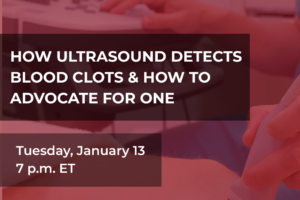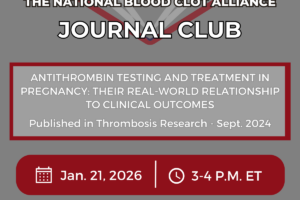Data Demonstrate Patient Awareness is Low, Despite Increased Risks
Tarrytown, NY — May 10, 2011 — Despite being at increased risk for deep vein thrombosis (DVT) and pulmonary embolism (PE), many hospitalized patients experience suboptimal DVT/PE prophylaxis in connection with their hospital stay, according to new survey results being unveiled by the National Blood Clot Alliance (NBCA) at the Society of Hospital Medicine (SHM) Annual Meeting in Dallas this week.
Data from NBCA’s online survey of 500 patients who had been hospitalized for >3 days, show that less than one-third of respondents report DVT prophylaxis with either an anticoagulant pill or anticoagulant injection, even though more than 40% of them report that they had a family member who previously had a blood clot in the leg or lung, and 15% say they had a personal history of a blood clot in the leg or lung. DVT prophylaxis reported by respondents include: 63% ambulation, 39% compression stockings, 37% mechanical compression, 37% aspirin, 29% anticoagulant injection, and 28% anticoagulant pill.
“These survey findings are compelling, because they demonstrate the gaps that need to be filled to optimize use of evidence-based DVT/PE prophylaxis, as well as the need to better inform or educate our hospitalized patients about potential risk factors,” says Greg Maynard, MD, MSc, SFHM, Chief, Division of Hospital Medicine, University of California, San Diego. As a member of NBCA’s Medical and Scientific Advisory Board, Dr. Maynard also serves on the Steering Committee for NBCA’s DVT/PE Awareness Survey, and is presenting findings of these survey data in conjunction with the SHM meeting this week.
Risk Versus Awareness
Hospitalization is a major risk factor for DVT/PE, with a 10-fold increased risk among hospitalized patients with acute medical illness. Despite these risks, the results of this survey demonstrate that DVT/PE awareness among hospitalized patients is low: Just 28% of patients surveyed say they are aware of a condition called DVT, when that term is used, and just 15% are aware of a condition called PE, when that term is used. Conversely, most hospitalized patients (83%) say they know what a blood clot is, and virtually all of them (99%) recognize that blood clots can be life threatening. However, almost half (46%) of all respondents say their doctor did not provide information about blood clot risks related to hospitalization.
“NBCA conducted its DVT/PE Awareness Survey in direct response to the Surgeon General’s Call to Action to Prevent Deep Vein Thrombosis and Thrombophilia,” explains NBCA Chief Executive Officer Alan P. Brownstein, MPH. “Our survey objectives included measurement of DVT/PE awareness among several at-risk groups, as well as the general public, and to benchmark information gaps and needs. These objectives are in keeping with Health & Human Services Secretary Sibelius’ recent Partnerships for Patients initiative, which includes a Centers for Medicaid and Medicare Services focus on preventing DVT/PE as one of several hospital acquired conditions.”
Additional Awareness Findings: General Public Vs. At-Risk Oncology and Hospitalized Samples
The NBCA Awareness Survey also was fielded among a representative cross section of the U.S. population, as well as a group of cancer patients. Chief among findings comparing awareness between the general public (n=500) and the at-risk hospitalized (n=500) and oncology (n=500) groups were:
- At-risk hospitalized and oncology patients are not significantly more aware of DVT/PE than the general public: On average, one-quarter in each group are aware of DVT when that term is used and 15% in each group are aware of PE when that term is used.
- Among respondents who could name DVT risk factors, just 1% of cancer patients mention “some cancer treatment,” and just 9% of hospitalized patients mention “surgery.”
- Among hospitalized and oncology patients able to name DVT risk factors, 63% in each group say they can name DVT signs/symptoms, significantly fewer than 79% of the general public.
- Approximately 1 in 3 of all respondents who say they know what PE stands for or what PE is claim that they can name PE signs/symptoms
Survey Methodology
NBCA’s DVT/PE Awareness Survey was conducted by the national survey firm USA/Direct, Inc. The hospitalized patient sample, screened from an online research panel, consisted of 500 adults, 20+ years (mean age 52.51), who had been hospitalized for >3 days within 12 months of sampling. The oncology patient group included 500 adults, 20+ years (mean age 57.84), screened from an online research panel, who had been diagnosed with cancer within 12 months of sampling. The general public sample reflected a representative cross section of 500 adults, 20+ years (mean age 46.06), screened from an online research panel.
NBCA is sharing additional results of its DVT/PE Awareness Survey findings at additional medical meetings in upcoming weeks and months, and through educational DVDs being made available to healthcare professionals in hospital medicine nationwide. For more information, or to order free copies of the NBCA DVT/PE Awareness Survey DVD, contact NBCA at www.stoptheclot.org, or 877.4No.Clot (877-466-2568).
NBCA is a patient-led advocacy organization dedicated to promoting patient and public awareness about the signs and symptoms of DVT and PE.
Additional Resources:
- NBCA DVT/PE AWARENESS SURVEY FACT SHEET
- Awareness and prophylaxis practices reported by recently hospitalized patients – Poster
- DVT/PE awareness among at-risk hospital patients and at-risk oncology patients compared to DVT/PE awareness among the general public -Poster
- NBCA DVT/PE Awareness Survey – Hospital Medicine – Video
The NBCA DVT/PE Awareness Survey was made possible by a grant from Ortho-McNeil™, a Division of Ortho-McNeil-Janssen Pharmaceuticals, Inc.






